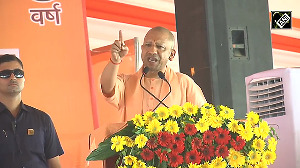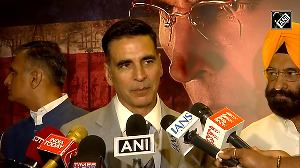May 21 marks 30 years since Rajiv Gandhi was assassinated in Sriperumbudur.
It is a day in infamy that will never be forgotten.

This interview was first published on Rediff.com on April 9, 1998.
The waiting assassin's bullet would probably get a nonchalant greeting: 'So what?'
But then, you can't expect anything less from the man who dealt a severe blow to one of the deadliest terrorist organisations in the world.
At his third floor home/office at an ITDC hotel in New Delhi, Special Investigation Team head Devarayapuram Ramasamy Karthikeyan is shutting shop, having handed over the directorship of the Central Bureau of Investigation, arguably India's premier investigating agency.
The man who investigated the most sensational murder case of the 1990s, the Rajiv Gandhi assassination, Karthikeyan spoke to Rajesh Ramachandran for 90 minutes discussing the Rajiv Gandhi murder, the Liberation Tigers of Tamil Eelam, and how the Jain Commission made his task difficult.
The first of a four-part interview:
How did the SIT manage to make such important breakthroughs in the Rajiv Gandhi assassination case and that too, so easily?
How soon did the SIT come to the conclusion that the LTTE and not Punjab terrorists, was involved in Rajiv's killing?
It is true it was a totally blind case.
On May 22, 1991, I was in Hyderabad as the inspector general of the Central Reserve Police Force, a call came from K P S Gill who was my boss at that time, that the government wanted my services to be utilised for investigating the Rajiv Gandhi assassination case.
I said I have no objection. But I didn't want to quit the CRPF because Gill and I had planned a lot of developmental activities and expansion.
So I said I can associate with the investigation but should not be taken out of the CRPF.
A few minutes later, the CBI director rang up.
He said he had a high level meeting in the morning where both the intelligence agencies said they had no clue at all as to who has done it.
How it happened, nobody knew.
So he said unlike the Mahatma Gandhi and the Indira Gandhi assassinations where people were caught red-handed, this case is totally blind, we don't know whether it would be like Swedish prime minister Olof Palme's assassination which remains undetected.
And that the government had decided to form a special investigation team as part of the CBI.
The unanimous opinion in Delhi was that I should be requested to head the team.
He said, 'I have been given the task of getting your consent.'
If it is more difficult than the Indira Gandhi and Mahatma Gandhi assassinations, and those cases were investigated by more senior officers, I said you should go in for a more senior person.
I said, 'I personally feel that I am unequal to the task.'
He said, 'No, you are the most competent man to handle the case.'
And I said, 'As long it is a call of duty I will not shirk the responsibility.'
Then spontaneously I put forth some conditions.
The first condition was, there should be no political interference.
I will go by facts and evidence.
I will not touch even a man on the street unless there is evidence against him.
Second was, I don't believe in third degree, I wouldn't like anybody in my team to use third degree against any suspect whether the case is detected or not.
Thirdly, I said the CBI name is big.
Twice I was invited to join even long back and had agreed, but then my state would not permit me to go.
But I know that the resources with the CBI are very minimal, you don't have manpower, you don't have security, you don't have vehicles and logistic support.
So I said I must continue to hold charge in the CRPF also.
They said it would be two different jobs... but I said I am not asking for the job.
Meanwhile I spoke to K P S Gill, he said 'ood that you said it, you do what you want, but don't leave the CRPF.'
At 3 pm the CBI director came back to me and said, 'I have accepted all the conditions, when can you go to Madras?'
At 3 pm it was communicated to me and at 5 pm I was on the flight.
At 6 pm I was in Madras.
While on the flight my only thought was that it should not be the LTTE. Because I knew the consequences if the LTTE's hand was there.
If at all, I only wanted not to find the LTTE's hand there.
I straightaway went to the director general's office, met some of the people who were on duty there and went to the hospital and the saw the injured.
Then instead of one week I went to Hyderabad after 90 days.
I told my family not to come down.
I had no time, I could not go.
We were working at least 20 hours a day, seven days a week, throughout the year.
No festivals.
I am a religious person, still I didn't go to temples.
I took it as a mission in life, not as a job to be done for a salary.
The nation's prestige was involved, its integrity and security were involved.
The tallest political leader of the time was killed brutally and it was totally blind. And no one expected the case to be detected, because there was nothing.
We have done hard work in the pursuit of truth.
What is investigation? It is nothing but the pursuit of truth.
I find five number 2s, I add up and I get 10.
On the scene we found a lot of clues, all of them pieced together we proved that it was done by a female.
The head and limbs were found strewn all over.
We found it was done through a belt.
A waist belt in which explosive was brought, connected with wire and switched on. So a bomb, a human bomb, because the body's DNA printing of all the limbs showed that this belt was worn by that person and all the limbs belonged to that person.
Okay.
Who is she?
It started like this.
And various other physical evidences were there.
Then the camera came: Haribabu's camera. The 10 exposed frames showed this woman with someone else: Sivarasan, Nalini and Subha.
Who are they?
Everyday I used to get hundreds of calls, meet so many people.
We have got thousands of calls and letters and all of them were seen by me personally.
Nothing was ignored, everything was investigated.
Which means out of the 5,000 letters I received only two or three proved useful.
Feature Presentation: Ashish Narsale/ Rediff.com










 © 2025
© 2025